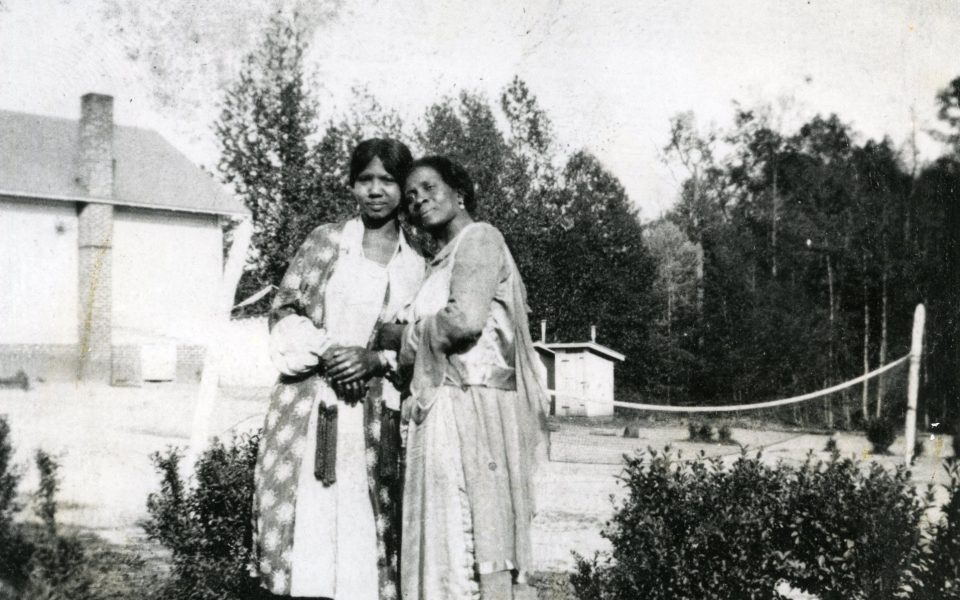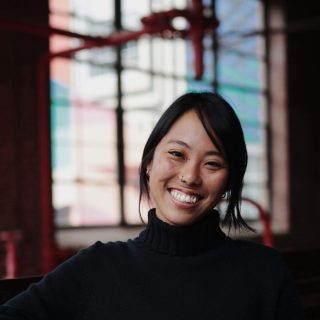Featured photo: Flora Pledger and Lillie Hamlin in Five Row (courtesy photo)
The two women, standing, gaze into the camera, half smiles tugging at the corners of their mouths. Their expressions look forced, tired; but they pose for the shot, arms intertwined, supporting each other as they do in life. Flora Pledger, like her name, wears a flowy floral dress and earrings while the older woman who leans on her, Lillie Hamlin, wears a similar, multilayered long-sleeved outfit. In the background, the side of a single building can be seen, its white exterior walls and brick chimney an example of the women’s residences. This was Five Row.
The black-and-white photograph is just one example of archival footage on display as part of Still I Rise: The Black Experience at Reynolda, a new exhibit which opened on Feb. 22 at the Reynolda House Museum of American Art. Like with the stories of Flora Pledger and Lillie Hamlin, the exhibit aims to tell a fuller, honest history of the Reynolda House, from before its inception to its conversion into a museum to present day, by including the experiences of Black, enslaved workers and artists. It’s a move many historically white institutions are making after the murder of George Floyd and Breonna Taylor in 2020 thrust into the American consciousness a renewed reckoning with its racist roots.

“While we wanted to celebrate the art moments in Reynolda’s history, we wanted to dig into Reynolda’s complicated history when it comes to race,” says Bari Helms, the director of archives and library for the museum.
The whole exhibit is tucked into what was a bedroom on the second floor of Reynolda House. It’s a text-heavy show, with small images scattered throughout. The journey starts with a sobering look at the origins of the Reynolds family’s wealth, stemming from the fact that Hardin William Reynolds — RJ Reynolds’ father — owned thousands of acres of land which was tended to by more than 60 enslaved persons. He was one of the largest slaveholders in that part of Virginia, the exhibit states. And this is how the show starts its reckoning, with an admission that RJ Reynolds, whose imprint on Winston-Salem is deep and pervasive, wasn’t a self-made man, but one whose familial ties to slavery aided him in amassing the wealth for which he would later become known.
But the story of Black people at Reynolda isn’t one-dimensional. Just as the history of Black people in America isn’t just one of oppression, but one of survival, creative thriving and celebration, so too is the experience of those who graced the land and halls at Reynolda House and Museum.
As the exhibit takes viewers through the decades, it becomes evident that those who served the Reynolds family were, at many times, grateful for their lives there. For example, Flora Pledger, who lived in Five Row — the community of row houses built specifically for the Black workers at Reynolda — looked back fondly at her time there.
“But I thought it was the best place I’d ever seen,” she states in the exhibit. “I loved it, I loved it. And if it had the water and electricity that I’ve got now, I’d rather be there than anywhere that I could be.”

And yet, at the same time, the exhibit explains how the community was built, out of sight from the Reynolds’ home and the nearby village buildings. It also lacked running water or electricity, which other homes on the property had at the time.
“It’s about telling Reynolda’s past in a more honest and truthful manner,” Helms says. “When it comes to Rise, it’s a work in progress.”
In addition to the story of the Black workers who tended to and maintained Reynolda House through the ages, the exhibit also delves into the museum’s relationship with Black artists. One of the main characters who cultivated and shaped that relationship was Maya Angelou, who championed Black art during her visits to Reynolda and eventually became the first Reynolds Professor of American Studies at Wake Forest University in 1982. During her first visit to Winston-Salem in 1973, Angelou gave a speech to a standing-room-only crowd at WFU in which she talked about what it meant to be an artist in a Black body. Afterwards, she reflected on the event saying, “I had pulled no punches, and softened no points, yet whites stood beside Blacks, slapping their hands and smiling…. I knew that morning, that one day I would return to the South in general and North Carolina in particular.”
Angelou bought a home on land that was once part of the Reynolda estate and died in Winston-Salem in 2014.
While just a portion of the already small exhibit, the throughline of how the museum has excluded, then welcomed, then embraced Black artists throughout the course of its existence provides vital context when viewed in conjunction with the museum’s other exhibits such as Black is Beautiful, also on display now.

“When we knew Black is Beautiful was coming, we wanted to do a companion archival exhibit to capture some of the themes of Black is Beautiful,” Helms explains.
Helms says that the museum has created an acquisition fund to increase works by women and people of color in the collection and that they will soon be installing audio interviews with Maya Angelou and artist Romare Bearden as part of the show.
And as much as the world has changed since Angelou’s talk five decades ago, Still I Rise also reminds viewers how much has stayed the same, and how much progress there is still to be made. With the wave of anti-Black rhetoric creeping into schools, the pushback to critical race theory and the objection by many conservatives to teach Black history, the exhibit emphasizes the absolute responsibility institutions like Reynolda have in telling the whole truth, and nothing but the truth.
“For people visiting the exhibit, I hope they leave with a richer understanding of Reynolda’s history and that Reynolda’s history is Black history and it’s interwoven,” Helms says. “To talk about history is to talk about Black history. It’s one in the same.”
Still I Rise: The Black Experience at Reynolda is on display at the Reynolda House Museum of American Art until Dec. 31. Learn more at reynolda.org.
Join the First Amendment Society, a membership that goes directly to funding TCB‘s newsroom.
We believe that reporting can save the world.
The TCB First Amendment Society recognizes the vital role of a free, unfettered press with a bundling of local experiences designed to build community, and unique engagements with our newsroom that will help you understand, and shape, local journalism’s critical role in uplifting the people in our cities.
All revenue goes directly into the newsroom as reporters’ salaries and freelance commissions.


Too bad they had/have no interest in the severe lack of diversity in their staff and reckoning with how poorly Black employees who have worked for them have been treated as recently as 2017.
yall are wild for this, they were ENSLAVED, they were NOT GREATFUL FOR THEIR LIVES THERE ARE YOU SERIOUSLY JOKING. the reynolda family may have treated them LIKE HUMANS but they WERE SLAVES, they were not greatful. what a funny way to say they “worked there” thats a funny way to put they were enslaved and not regularly beaten girl what
I just want to clarify so im VERY CLEAR- saying the Black workers/enslaved people at Reynolda were “grateful for their lives there” is deeply misleading and harmful . They were enslaved. They were not grateful to be enslaved. What Black people have always done, across generations, is turn unimaginable suffering into joy because we had no other choice. Negro spirituals, soul food, blues, jazz so much of our culture and creativity was born out of survival and resilience, not “gratitude” to the people exploiting us.
Unless you’re claiming that during Jim Crow Reynolda provided some kind of safe haven for free Black folks (which I highly doubt), it feels disingenuous to frame it this way. The Reynolds family’s immense wealth was built on stolen labor, by force. Reynolda still exists because of that labor. If the museum truly wants to reckon with history, that should always be centered — not smoothed over.